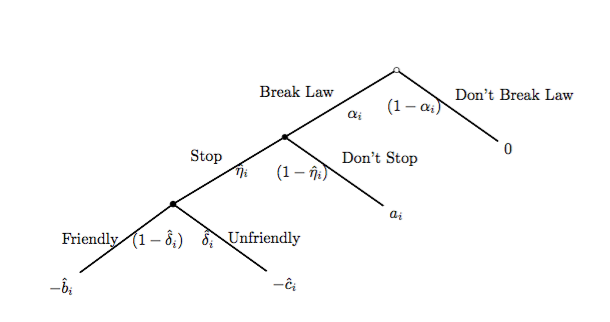Editor’s note: This post is part of a series showcasing BSE master projects. The project is a required component of all Master’s programs at the Barcelona School of Economics.
Abstract
We study the effects of the #BlackLivesMatter movement on the law abiding behavior of African-Americans. First, we derive a conceptual framework to illustrate changes in risk perceptions across different races. Second, we use data from the Illinois Traffic Study Dataset to investigate race ratios in police stops. For identification, we apply a linear probability OLS regression on media coverage as well as an event study framework with specific cases. We find that the number of black people committing traffic law violations is significantly reduced after spikes in media coverage and notable police shootings. In the latter case, we further find that the effect holds for an approximate ten day period. We argue that these observed changes in driving behavior are a result of the updated risk beliefs.

Conclusions
Beginning with our model, we show that media related changes in risk perceptions cause a change in the proportion of people committing crimes. Using this model, we further predict that this change would be different across different racial groups. More specifically, it predicts that Blacks became more cautious in order to decrease the chance of a negative interaction with the police. On the other hand, whites were predicted to not change their behavior, since the violence in media coverage is not relevant to their driving decisions.
In order to test our model, we develop a hypothesis testing strategy that allows us disentangle police actions from civilian decisions. By considering the proportion of stopped people who are black at nighttime, we completely remove any effect caused by changes in policing intensity and bias. Instead, we create a testable hypothesis that only focuses on the differences in behavior between racial groups.
To test this hypothesis, we use a linear probability model along with traffic data from Illinois. We test the hypothesis using both an event study approach, as well as using media intensity data from the GDELT Project. Both approaches verify our model’s predictions with high significance levels. Therefore, we have shown that Blacks became more cautious in response to these events compared to other racial groups. In addition, our robustness check on the total number of stops supports the claim that non-blacks do not have a significant response to media coverage of police brutality toward Blacks. This leads to the conclusion that the expected proportion of Blacks breaking traffic laws goes down in response to coverage of these events.
An implicit assumption in our model was that as media coverage goes to zero, Blacks would revert back to their original level of caution. To test this we looked at three days intervals following each media event. We showed that after approximately 10 days, the coefficients were not significant anymore, showing that the media only caused a short term change in behavior. Since this was a robustness check, and not a main focus of our model, we did not investigate this further. This is an interesting conclusion, and warrants future analysis.
On a final note, we want to address the type of media we use for our analysis. Our model section considers media in a general sense. This can include, but is not limited to, social media platforms such as Twitter and Facebook, as well as more traditional media platforms such as television and print newspapers. All of these sources cover police brutality cases at similar intensities. We use TV data for media intensity, since it affects the broadest demographic and therefore best represents the average driver’s exposure to the topic. Different media age medians might affect different demographics more or less. For example, social media may have a greater effect on younger drivers than older drivers. We believes this topic warrants further analysis, in a addition to the topic of the previous paragraph.
Authors: Julie Balitrand, Joseph Buss, Ana Monteiro, Jens Oehlen, and Paul Richter
